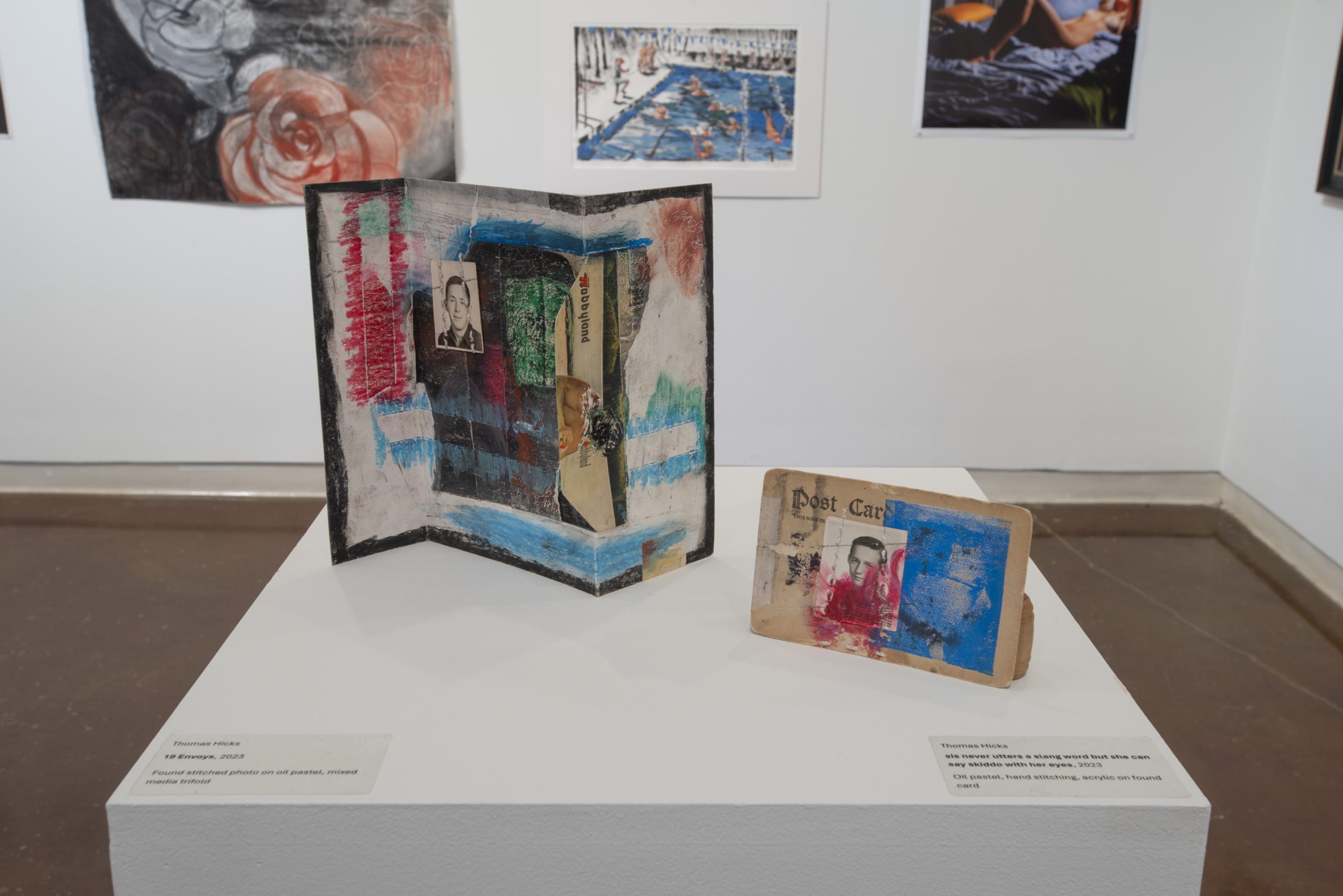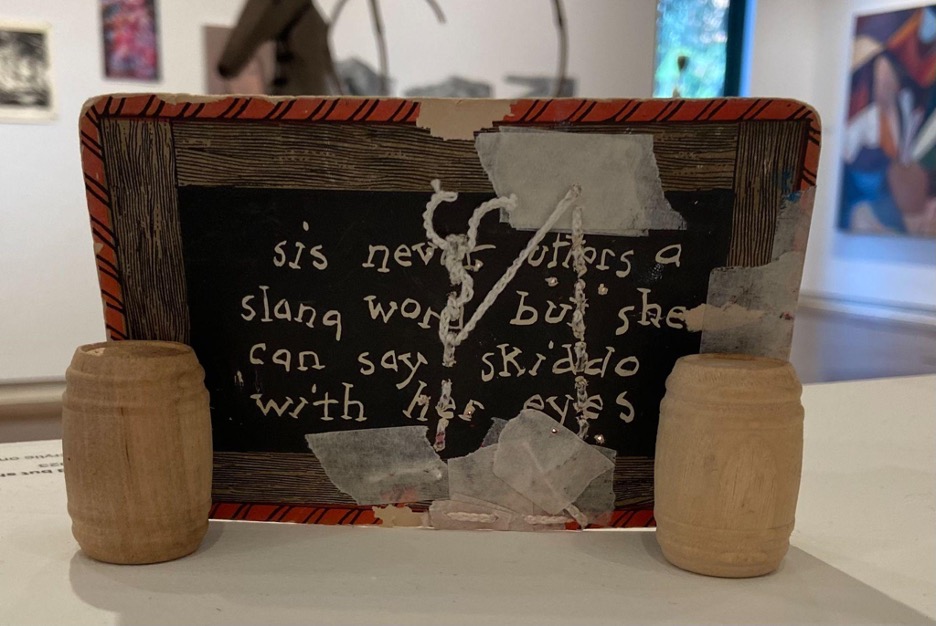


Intern extraordinaire Bree Weaver interviews Thomas Hicks to learn more about the artist’s creative practice and the work featured in this year’s Young Contemporaries 2024 exhibition.
Introducing Thomas Hicks, a familiar face to the Halsey Institute’s Young Contemporaries exhibition, having graced the show for three consecutive years. Thomas has had three pieces featured annually in this exhibit going back as far as 2022. Thomas primarily works in mixed media, with a particular focus in photography. He has recently completed the Lightning Residency at Redux Contemporary Art Center, less than a mere two miles from the Halsey in Downtown Charleston. In our interview, we delve further into his creative process, artistic intentions, and future endeavors. Join us as we explore the inspiring world of Thomas Hicks.

Thomas Hicks, untitled (one), 2023, Tea-stained cyanotype, stitched and colored found photo
Bree Weaver (BW): How do you feel about having three of your pieces in Young Contemporaries 2024?
Thomas Hicks (TH): When I submitted my six, those were the three that I was living for. I think those are the three strongest ones. I was happy that I turned the big tea piece with the pink [untitled one] into a diptych because I originally had all of the work placed beside each other, and I was thinking: “you know, this could work as a solo piece.” So it was fun to take a diptych and then submit it and then I was like, slay, purr. It shows that I can be quick on my feet. I know this sh*t. Period.
BW: All of your pieces in the exhibition were made from found objects, were they all found in the same place?
TH: So, no. The tea picture [untitled one] was a set of large format negatives I got in high school and then the other pictures I got kind of recently. They were all bought from eBay and I’m pretty sure they all came in a collection. I think it was a group of like 20 pictures and it’s kind of crazy because in my work I notice that the pictures do come in a collection, I do tend to keep them together. Rather it be like a collection of the same person or it being bought together. I like to build a narrative.

Thomas Hicks, sis never utters a slang word but she can say skiddo with her eyes, 2023, oil pastel, hand stitching, acrylic on found card (front)
BW: The title of your works are so interesting, can you tell me more about how you titled: 19 Envoys and sis never utters a slang word but she can say skiddo with her eyes?
TH: So most of my found images are from the past. The postcards go back to the 1920s. I collect everything, but my postcards that I collect and work on range from the 20s, 30s, 40s, 50s. That’s why I kind of live for the postcards, because each postcard is different. I’ve seen crazy graphics, some cool words. Like when I saw the sis never… I liked that little quote. It was very intriguing to me. When I read it, I was like, “what does it even mean?” and then it just happened to be the postcard I was working on. I wasn’t really worried about the back. It kind of just all fell into place. It all just, you know, worked. But the title is just the back of the postcard. It doesn’t really have any meaning more than that. I worked very intuitively, so I wasn’t really worried about the back just yet. But the back does play a big importance because of the stitching of the photo and I love incorporating the front and the back with the piece, especially with flat pieces like that because, first of all, it makes it sculptural. And second, I just don’t think people think about the back of artworks or about the whole piece and that’s what I like to think about.

Thomas Hicks, sis never utters a slang word but she can say skiddo with her eyes, 2023, oil pastel, hand stitching, acrylic on found card (back)
19 Envoys was actually when I was at Redux. I forgot the name of the photographer but it was him and his kids. And basically I was there late at like five or six o’clock and they came into my studio and I let them look at my work and I’d show him the piece and ask, “what do you see?” and I just love hearing people’s interpretations of my work because I don’t get the interpretation first – interpretation comes later for me. I do think about some stuff here and there, but like that’s just my own personal thinking. But he said something about spies, envoys, he said the number 19, he was talking about a car, a murder. I was just wanting him to say words, list out things that he got from it. And 19 Envoys was something that just clicked. Because when I see the piece, I do see some type of car or vehicle in a way, especially with what I did, it just adds this kind of, you know, dimension. So 19 Envoys just made sense in my head.

Thomas Hicks, 19 Envoys, 2023, Found stitched photo on oil pastel, mixed media trifold
BW: What do you hope a viewer would get out of your work?
TH: Well, there is that sense. I feel like for my photography, it’s a sense of some loss or that you can get lost. I get more of a stand-in portrait, like for me and my relationship with my father sort-of-kinda. I don’t want that to be the first thing you read because this is not about me, well, it is about me, but you don’t need to know that. It really is what you get from it because I feel like people get the metaphors, because yeah, I want you to get that. But the other stuff, the deeper meaning and the stories, that’s for you to figure out. In my sketchbook, I do this list of keywords and it’s how I work. Keywords drive me and people usually get those keywords when the look at the piece and then, like I said, you think of your own story.
BW: What is your creative process like?
TH: It was while I was at Redux for my Lightning Residency. I’m really messy. First process is messy. So, I had my stuff laid out on the table. I’d pin some stuff up on the wall, that’s usually with stuff that I knew I was gonna work on. As soon as I pinned it on the wall, that’s usually with stuff that I knew I was gonna work on. As soon as I pinned it on the wall, I would come up to it and I’ll take it down and play with it. So it was like a little collage wall. I was doing a lot of pastels. Playing with them and like, pastels were new to me so exploring the medium and figuring out what I like about it. There’s really no dislikes. I really do love pastel. I would come in each day and it would be something different. Whenever I felt like I was working on a piece too much or I didn’t know how I felt, I’d just leave. But during that residency, I was in the studio for four or five hours every day, like I lived there. You can ask anybody. Your girl was there 24/7. But usually I just keep it all messy and I pin up the important things. And my art usually just comes over the days but I really am intimate with the work. I’m very close with it. The stories eventually, kind of, you know, puzzle themselves out.
BW: I know you graduate next year, do you plan on pursuing art post graduation?
TH: Yes, I want to go to grad school or art grad school. I know I’m gonna be an artist. I know my work needs to be seen, and I have all the capabilities for that to happen. And so yes, I’m gonna be a working artist. Grad school, hopefully after this. One of my professors and I were talking about UCLA, like LA, a big city. Because, you know, to get my artwork out I need to go big. I need to network! But yeah, grad school, the end!